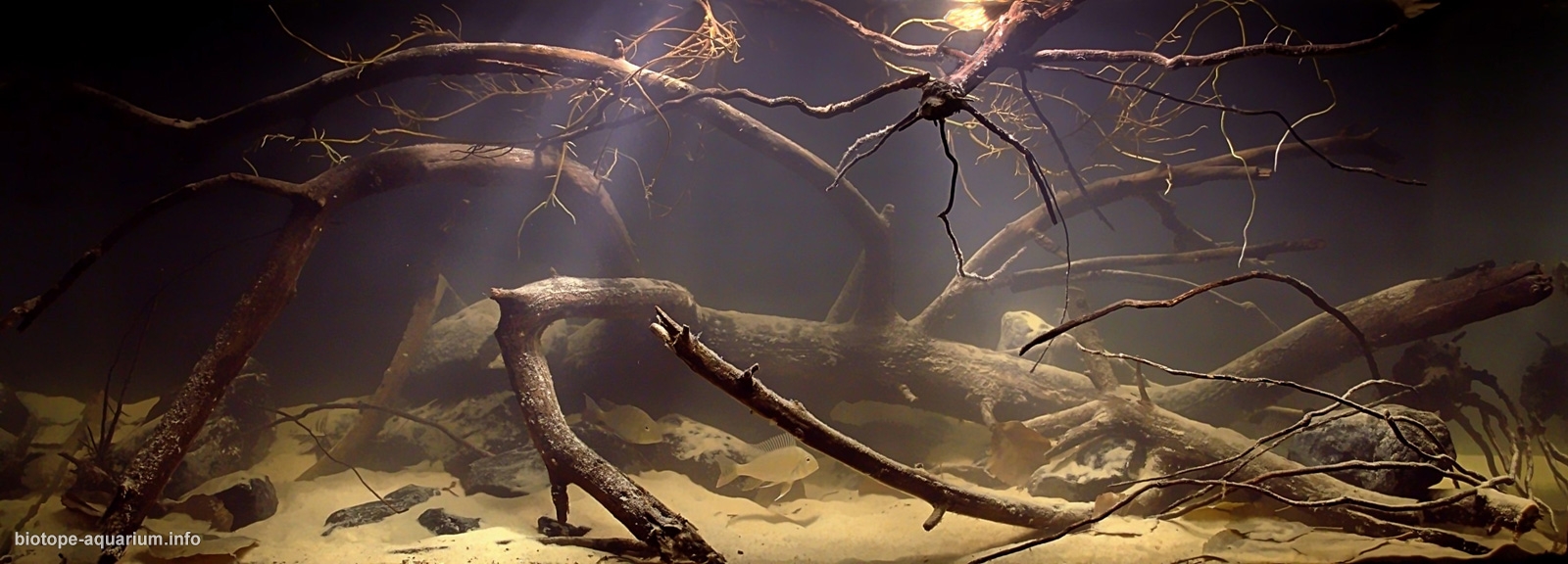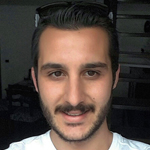The Republic of Suriname, Gran Rio, the tributary of the River Suriname, downstream from the Avadana rapids
8th place in Biotope Aquarium Design Contest 2017
![]() Ukraine. Bogdan Oleynik
Ukraine. Bogdan Oleynik

Volume: 480 L
Dimensions: 160x50x60 cm
List of fishes: Geophagus surinamensis
List of plants: N/A
Description of decorations: In the aquarium, apple tree is used to imitate driftwood that are located near the coastal, heavily forested areas of the tributaries of the Grand Rio. Its meandering shape, obtained during heavy snow, very much resembles tree tops in the video “Suriname Highlights 2014,” (23.55 min). I also used the roots of vine and the roots of Monstera to imitate the roots of trees in coastal areas that are directly in the water as shown in the video “Aquatic Discoveries: Suriname 2012” (18.07 min). Also from the two above mentioned videos, I found out the substrate in the form of sand of the most suitable color for this part of the pond. Stone piles in the aquarium in shape, type and color resemble stones of the hills of the Eilerts de Haan mountain range surrounding the tributary of the Grand Rio. Also, to give realism to the aquarium, the alder leaves were used, which in their form are similar to the leaves in the water, as shown in the video “Suriname Highlights 2014” (22.00 min).
Description of equipment: Filtration: Two external filters, Jebo 839 (1500 hp) and Atman CF1200 (1550 hp); sump 90 liters; phytofilter 150 x 20 x 20 cm (60 liters). Lighting: lamps 12W 3000K and 20W 4000K. Additional equipment: heater 300W; compressor 8 l/min; lifting pump; autonomous power source; electronic timers.
Water parameters: Temperature 27-28°С, PH 6.5; KН 7; GH 9.
Description of the area surrounding the biotope: The Gran Rio is the main tributary of the Suriname River and runs from the northern hills of the Eilerts de Haan mountain range. “The Great River”, as it is also called by the inhabitants of the surrounding regions, has a stony bottom, so the islands of stone piles rise in places, with a large number of rapids with strong currents, providing tourist interest, and also a refuge for many species of fish. On the sides of the river there is a dense forest, trees and plants that are located at the very edge of the coast, whose roots directly go deep into the water, thus providing not only shelter for different species of fish and other animals, but also keeping the coastline with their strong root system, so the river doesn’t wash them. The Grand Rio River has unique flora and fauna, it is enclosed in picturesque landscapes, making this place truly fascinating.
Description of the underwater landscape of the biotope: The terrain that I displayed in my aquarium is located in calmer waters, somewhat downstream from the stone rapids of Avadan, the tributaries of the Grand Rio. Such conditions attract many species of fish, who like more calm living, thus forming its own ichthyofauna of this area. In my aquarium I wanted to show a segment of the life of a small group of young Geophagus surinamensis who swim further and further making their first independent attempts to study their habitat in order to take their rightful place in the wild. Holding each other they are timidly and slowly looking for food, trying to hide from the current and predators in the coastal zone, among the gorges of stones, the roots of trees that are in the water and the debris of old driftwood melting slowly in the waters of the tributaries of the Grand Rio. They still do not feel confident, this world more and more often scares them with their natural course of life. But soon they will learn to live in such a beautiful but dangerous place and their school will become smaller. Having matured, having gained strength and experience, each of them will start to live an independent way of life, eventually they will find themselves a couple, a life partner, and form their own family and their own flock, contributing to the balance of the nature of such a wonderful reservoir as the tributary Grand Rio of the Suriname River.
Description of the parameters of the habitat: Parameters for 2004. The water in the river is turbid, with an average transparency of 3 m, temperature (0-5 m) 29.1-33.1°С, (20-25 m) 27.4-29°С, PH (0-5 m) 6.7-7.3.
List of fishes: Apistogramma steindachneri, Crenicichla multispinosa, Crenicichla saxatilis, Geophagus surinamensis, Guianacara owroewefi, Krobia guianensis, Leporinus fasciatus, Anostomus anostomus, Leporinus grandti, Cyphocharax helleri, Cyphocharax spurious.
List of plants: N/A
Sources of information:
- https://www.youtube.com/watch?v=2fBOsJ0I81w&index=3&list=PLfyVVb0NpOXNXA9I75vmQB0SLwdo2–6a (Suriname Highlights 2014);
- https://www.youtube.com/watch?v=TXda1XG5sPc&index=2&list=PLfyVVb0NpOXNXA9I75vmQB0SLwdo2–6a (Aquatic Discoveries: Suriname 2012); “Suriname” by Philip Briggs:
- https://books.google.de/books?id=FtTeBgAAQBAJ&pg=PA3&hl=ru&source=gbs_toc_r&cad=3#v=onepage&q&f=false
Comments of the members of the jury of Biotope Aquarium Design Contest 2017

It was one of the most natural-looking tanks in the race and even can be the most natural. Especially l liked the lighting system of this biotope; this was the most natural light on contest. This aquarium has very good looking but l cannot say very well designed for this aquarium because this design look like created almost from one piece of driftwood. This huge and gorgeous piece of driftwood filled the all parts of tank. You could design the bottom of this tank better. I wish, to see another different species in this biotope. Your aquarium volume is suitable for more species. Despite some minor shortcomings, it’s one of the best biotopes in the race. Congratulations!
Lots of water and not too many animals – that’s what I like. The configuration of this tank is simple, yet very good. The bottom is sandy but diverse, I mean, there are many different places for the fishes to dig in, some with stones, some with roots, and some with just pure sand, these cichlids will never get bored. There are also good hiding places, the light is dimmed, and the water is slightly cloudy, all these features sum up to a very natural-looking layout.
